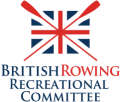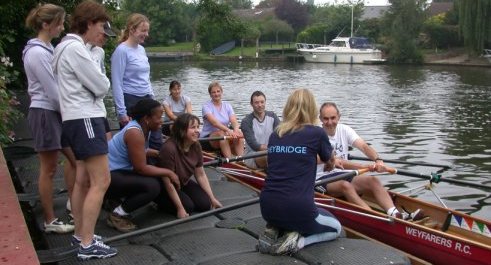


Learn to Row
All clubs affiliated to British Rowing are listed on the BR website. Most of these run Learn to Row courses.
Example Learn to Row Course
There is no set format for a Learn to Row course - it can be anything from 6 sessions upwards - but if you are lookng for ideas, here's an outline of the course we run at Weyfarers RC.
- The course is 10 sessions with 2 sessions per week over 5 weeks. Most of the course is run in stable coxed quads, with a coach (usually in the cox's seat) and an experienced rower, who may sit at stroke to demonstrate the exercises, or else at bow to check what is happening along the boat and help with steering if conditions are tricky.
Session 1
Land session - introduction to the club, safety rules, boat types,
explain the differences between rowing and sculling
Rowing technique using the ergo
Practice techniqe using rowing tank (if available) or stable single on land
(if available)
Session 2
Carrying and launching the boats safely, placing the blades in the
swivels
Getting in and out, adjusting the footstretcher, holding the blades
correctly
Safe position - good posture
With the boat attached to to the pontoon, rowing normally and backing down
with one hand
Pushing off, confidence drills (raising and lowering the hands, leaning one
side and the other, slapping the water, circling the hands)
Manoeuvring the boat by rowing forwards and backwards with each hand, then
both hands together, fixed seat
Stopping the boat
If time, rowing in pairs with square blades
Session 3
Revise learning points from session 2
Rowing in pairs with square blades
Note: Traditionally most clubs start from fixed seat and gradually
work up the slide. However we think some people learn the technique
more quickly starting from frontstops and taking a full stroke. You
could try both!
If sufficient progress, rowing full crew
Useful exercise: dabbling the blades at the finish, at hands away and at the
catch to demonstrate hand heights and depth of blades in the water
Session 4
Feathering the blades.
We find it helpful to have each crew member in turn squaring and feathering
the blades in the air, then rowing individually before rowing together
Useful exercises: tap down and feather with fixed seat, single strokes from
hands away
Session 5
Skill drills aiming at good bladework
e.g. double feathering, roll-ups
Emergency stop (practise at each session from now on)
Exercises:
Session 6
Improving overall technique and crew cohesion with appropriate exercises
e.g. eyes closed, feet out of straps, upside-down feathering
Explain/demonstrate basic boat adjustments
Session 7
Working on rythmn, ratio and power, with appropriate exercises
e.g. "bums off seats" - each rower in turn starting from frontstops lifts
themself off the seat with the rest of the crew sitting the boat
"Pineapple chunks" - ratio "pineapple, pineapple, pineapple CHUNKS" - take
the stroke on "chunks"
Air strokes - one normal stroke followed by one stroke where blades do not
enter the water (also good for balance)
Session 8
Coxing and navigation rules. Each learner takes it in turn to cox, pushing off from the pontoon, turning and returning to land.
Session 9
Single and double sculls, using stable boats with floats if necessary. Coaching from launches or bow seat of double
Session 10
Mini-regatta and party